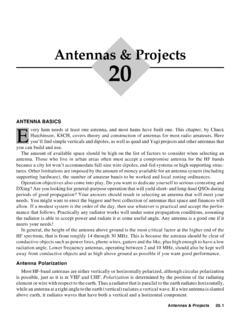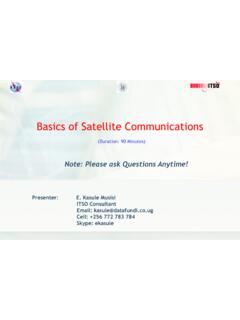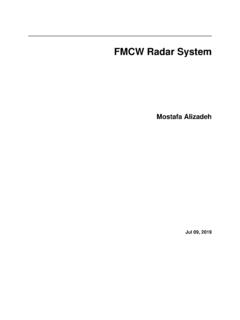Transcription of The 43 Foot Vertical
1 The 43 foot Vertical Bill Leonard N0CU 9/3/2016 This presentation is based upon charts from: The 43- foot Vertical by Phil Salas -AD5X (Comments in BLUE are mine, not Phil s) 1) Multiband Fixed Height Vertical using Traps 2) Multiband Variable Height Vertical using the SteppIR BigIR III 3) Multiband Fixed Height Vertical using an antenna matcher in the shack such as 43 footer 4) Multiband Fixed Height Vertical using an antenna matcher at the antenna base 43 footer again 5) Forget the Vertical and get a multiband dipole Multiband antenna Options 1) Multiband Fixed Height Vertical using Traps 2) Multiband Variable Height Vertical using the SteppIR BigIR III 3)
2 Multiband Fixed Height Vertical using an antenna matcher in the shack such as 43 footer 4) Multiband Fixed Height Vertical using an antenna matcher at the antenna base 43 footer again 5) Forget the Vertical and get a multiband dipole Multiband antenna Options No one antenna is best for all applications! Concept Behind the 43 foot Vertical - Take a resonant Vertical monopole antenna that works good one band, but is unuseable on most other bands, and change it so it is useable on a number of bands. - The 43 foot length is non-resonant on any band (impedance matching is required on all bands) - Why a Vertical ? - Important characteristics of a Vertical antenna - Ground Losses and antenna Efficiency - Why a 43- foot Vertical ?
3 - SWR-related coax and unun losses - RF Voltages - Matching Networks for 160-and 80-meters - Building your own 43- foot Vertical AD5X Outline (Last two topics not covered in this presentation) Advantages: - Generally are inexpensive - Relatively unobtrusive - Self-Supporting - Easy to ground mount - Low angle of radiation (maybe, maybe not) - Good DX performance (maybe, maybe not) - Omni-directional (no rotator needed!) Disadvantages: - Omni-directional (no gain or F/B) - Needs a good radial system for best performance - Needs good ground characteristics for best performance Why Use a Vertical ? - Efficiency: - How much of the transmitter power is being radiated - Can be a significant problem with vertically polarized monopole antennas - Determined by: - antenna design (radiation resistance) - Ground characteristics in the NEAR FIELD (~1/2 wavelength) -Conductivity & permittivity - Pattern - Is the transmitted power going where you want it to?
4 - Peak gain - Take-off angle - Determined by: - antenna design - Ground characteristics in the FAR FIELD (~10 wavelengths) Important Characteristics of a Vertical antenna - A Vertical monopole antenna installed over a poor ground with no radials will have: - Very poor efficiency and - Poor pattern (low gain and high takeoff angle) - A Vertical monopole antenna installed over a poor ground with an ideal radial system will have: - Near 100% efficiency and - Poor pattern (low gain and high takeoff angle) - A Vertical monopole antenna installed over an excellent ground (without any radial system) will have: - Near 100% efficiency and - Good pattern (good gain and low takeoff angle) Important Takeaway - Radiation Resistance (Rr) is the effective resistance of the antenna - Hypothetical resistance (not a real resistor) - Value varies from milliohms to thousands of ohms - Ground loss (Rg) is power lost due to heating of the ground - antenna Efficiency (%) = 100 x Rr/(Rg + Rr) -Assumes X is tuned out by impedance matching network Vertical antenna Efficiency antenna Rg Rr X - 43 foot antenna on 160 meters.
5 Rr = 43/128 X 36 = 4 ohms - EZNEC = 3 ohms C = x 43 = = -j580 ohms - EZNEC = -j640 (VNA actually measured j580) - Nearby objects add some stray capacitance Simple Calculations Efficiency Calculation - A -wave Vertical has a radiation resistance of 36 ohms - Assume 10 ohms of ground loss - Probably a much better ground than most hams have - SWR = :1 - Rr + Rg = 36 + 10 = 46 ohms - SWR = 50/46 = - antenna efficiency is 78% - If you have a 100 watt transmitter, you will radiate 78 watts Note: - Higher ground loss can result in a BETTER SWR! Electrically Short Antennas - The shorter the antenna , the lower the Rr - A Hustler 6 BTV 80/40/30/20/15/10 meter Vertical is 24 feet tall - On 80 meters, it is only wavelength long - Rr decreases approximately as 1/(length)2 - So Rr is approximately 5 ohms - With 10 ohms ground loss, the efficiency is 33% - Assumes no trap/inductor losses (trap loss could add 2dB) - Now your 100 watt transmit signal results in only 33 watts being radiated Electrically Short Antennas (cont d) - A Butternut HF-9VX with TBR-160 160M loading coil is 26 feet tall - On 160 meters, it is only wavelength long.
6 - Rr decreases as 1/(length)2 - So Rr is approximately ohms - With 10 ohms ground loss, the efficiency is 13% - Assumes no inductor/loading coil/matching losses -Now your 100 watt transmit signal results in only 13 watts being radiated Matching losses could easily drop this number below 10 W The 43- foot Vertical antenna Advantages - Still can be self-supporting & moderately unobtrusive - Approximately 3x higher radiation resistance than the typical trap or loaded Vertical . - No trap or loading coil losses to worry about - Modest compromise SWR from 60-10 meters when fed with a 1:4 unun.(UNUNs are designed to work with resistive loads!) Disadvantages - Take-off angle is not optimum on 12/10 meters - More on this later - You need an in-shack tuner (remote tuner is much better) 43- foot SWR over Perfect Ground with 1:4 Unun at the antenna (EZNEC) Note: - These values will be different with a real (lossy) ground - Many built-in HF antenna tuners only go up to 3:1 SWR Efficiency Comparison - The Hustler 6 BTV on 40 meters - The 24- foot Hustler is wavelengths long - Rr = 20 ohms - Efficiency = 67% (assumes Rg = 10 & no coil losses) - Note.
7 There are multiple inductors (traps) in-line on 40 meters - The 43- foot Vertical on 40 meters - antenna is wavelengths long - Rr = 65 ohms - Efficiency = 87% (with Rg = 10 with no coils/traps) - The required tuner may have more loss than coils/traps 43- foot antenna Disadvantages - Can be moderately (very) expensive - High take-off angle above 15 meters - DX performance >1/4-wave Vertical 60-15 meters, but 5dB down from 10 meter -wave Vertical at 10 degree take off angle (but higher Rr compensates some) - Really needs base matching on 160/80-meters - Regardless of what the 43- foot antenna vendors say - Example: With Rg = 10 - 160 Meter SWR = 324:1, 80 Meter SWR = 41:1 Matching & Coax Losses - Some 43- foot antenna vendors claim the antenna can be matched from 160-10 meters with your in-shack tuner.
8 - One vendor says to use 150 feet of RG-213 for best all-band operation of the 43- foot antenna (so you can tune from the tuner in your shack). Another vendor says to ADD 150 feet of RG-213 to your cable run. - The typical 160 meter base impedance of a 43- foot antenna with the 1:4 UNUN is 2-j183. 150 feet of coax transforms this to a matchable 38 + j180 (?) at the shack. - But the antenna SWR is ~ 150:1 resulting in 12dB (two S-units) of coax losses due to the SWR at the antenna . Plus about 6dB ground loss. Total loss ~18dB. -TX = 100W results in 2-watts radiated (No! 2 W reaches ant) Some antenna mfgs don t understand the basics!
9 To Maximize Efficiency - Minimize coax loss: - Use shortest length possible - Heliax semi-rigid cable - LMR-400 coax - RG-213 coax -Do matching AT the antenna - Install the best radial system you can afford - Do the matching at the base of the antenna - For high power & high SWR, may need to use relay switching - Matching on 160/80 meters is difficult - The mismatch may be too great for most manual/auto antenna tuners - VERY high RF voltages & currents RF Voltage & Current - An electrically short antenna has high capacitive reactance. This WILL cause high RF voltages across a matching network. - Example: Assume 1500 watts and a perfect ground system (Rg = 0) on 160 meters.
10 In this case all power is delivered to Rr. At the base of the antenna : I = (1500/3) = amps rms |Z| = (32+ 6002) = 600 (?) So, Vrms = x 600 = 13,440 and Vpk = 19,007 volts (?) Don t overlook UNUN current & voltage limitations Matching Network Issues - Any antenna with low Rr will have large RF current -Inductor & capacitor heating & contact degradation on switches & relays -Any antenna with high X will have large RF voltage at the feed point -Safety concern! -Capacitor/switch/relay breakdown in matching network Vertical antenna Pattern Over Real Ground Ground characteristics affect both efficiency and radiation pattern - Lossy ground results in: - Lower gain - Higher takeoff angle (pattern may be no better for DX than a dipole) Wave Monopole Perfect Ground Lossy Ground -Peak gain down 8 dB from ideal Vertical -Peak gain @ 30o (not 0o) Peak gain down 6 dB compared to dipole Vertical antenna Pattern Over Real Ground Ground characteristics affect both efficiency and radiation pattern - Lossy ground results in.










